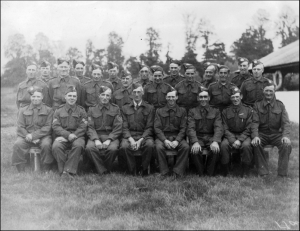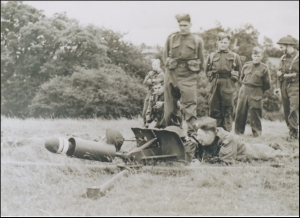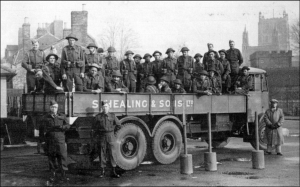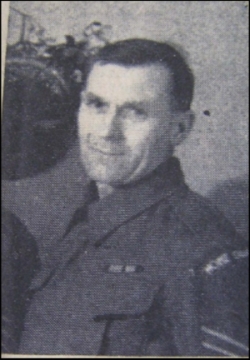Tewkesbury Home Guard (Part 2: 1941-44)
1941 The Force Grows in Stature and Efficiency
1942 The Year of the Introduction of Compulsory Service
to Expand
1942 A Year of Tragedy
to Expand
Hanlon was 47 years of age on the day of the accident and was described as an enthusiastic member of the Tewkesbury Home Guard Company. He had served in the Tank Corps during the Great War and, after a period of garrison duty in Germany, was ‘demobbed’ in 1919. He had been one of the first to volunteer for the LDV and his enthusiasm and attention to duty had been an example to everyone. He lost his life on 19 November 1942, as a result of an accident during indoor ‘Spigot Mortar’ practice at Healings Mill. An explosion had occurred which not only severely injured Sergeant Hanlon in one leg, but also flung over colleague, Richard Wise, and demolished a wall at the mill.
1943 Increasing Demands
Separate research indicates that a number of heavy anti-aircraft gun batteries were located in a broad circle around the 'Gloucester/Brockworth Gun Defended Area' [GDA] to protect the factories at Hucclecote and Brockworth, which were providing aircraft for the air war against Germany. This GDA also included the important Rotol airscrews factory at Staverton. Each gun battery would have a cluster of four or more 3.7-inch calibre anti-aircraft guns, radar and gunnery control facilities, and the small encampment for the crews, remembered by Harry. Eighteen such batteries were located around this GDA for most of the war.[30]
1944 The Final Call to Arms and Stand Down

1945 Disbandment and Disillusionment.
Perhaps surprisingly, the stand down was not universally well received in the Home Guard. Many felt that they had been prematurely sidelined and too quickly disarmed, thereby destroying the sense of comradeship that had built up during the war years. Some units tried to keep the spirit alive by forming Home Guard Associations and rifle clubs, but no evidence of this has been found for Tewkesbury. However, the local newspaper did record the suicide of George Simpson of the Evesham Battalion, who had been depressed since stand down. It was reported that he had missed the companionship and had lost interest in everything. He was described as an old soldier who took his war seriously.[36] The force lingered on to be disbanded finally at the end of December 1945.The 1950s and the Cold War
Although the final disbanding of the wartime Home Guard in 1945 seemed to be the end of the force as far as the men were concerned, discussions would soon take place in various government defence committees during the post-war era about the reconstitution of the force in case of future wars.[37] New perceived threats to Britain during the ‘Cold War’ period, particularly the Berlin Blockade in 1948, added impetus to these discussions, which included the possibility of reviving the Home Guards as a defence against air landings (just as before), to help the police in controlling civil unrest and dealing with a possible communist inspired ‘Fifth Column’. The start of the Korean War signalled a further communist expansion and more discussion. However, it was the return to power of Winston Churchill in 1951 that actually brought about the re-formation of the Home Guard. The consequential Home Guard Act of December 1951 required volunteers to sign on for two years, and undertake a minimum of 15 hours training every three months. Recruiting was very much slower than in 1940 and most units did not reach the size envisaged. Tewkesburians, again, volunteered for this new force, but little is known about organisation in the town or what they did. The new force reverted to reserve status in April 1956 and ceased to exist in the July of that year.[38]Conclusions
"there was no question that the Home Guard had thoroughly justified the decision to recruit it little more than three months ago. The Home Guard for the most part proved their efficiency for the important military duties assigned to them and have thus established their value as an essential part of our system of Home Defence." [39]
Archaeology of Tewkesbury Home Guard
References
- National Archive [NA], WO 163/414, Home Guard Sub Committee of the Army Council.
- Harry Workman: each time he is cited it is from personal comments, when interviewed on 27 January 2011.
- [Editor: Richard Innes Comins of the Uplands, landlord of the Plough Hotel, 1942-44, Woodard Database.]
- Gloucestershire Record Office, M11, A Short History of the 1st Gloucestershire Battalion Home Guard. Gloucestershire Record Office, M11. (Unless otherwise stated, this is the source of information on the local Home Guard.)
- Jon Mills and Terry Carney, In the Space of a Single Day, Wardens Publishing, 2001.
- Regulars of the 162nd Infantry Brigade; Home Guard units from Churchdown and Dymock; the Aston Somerville, Bredon and Kemerton Platoons of the 4th Worcestershire (Evesham) Battalion Home Guard; the Upton Company of the 7th Worcestershire (Malvern) Battalion Home Guard; and A and E Companies of the 1st Gloucestershire (Cheltenham) Battalion from Bishop’s Cleeve.
- The ‘Harvey Flame Thrower’ comprised a large pressure cylinder filled with flammable fluid, with a cylinder containing compressed nitrogen attached and connected to provide the propellant. A long flexible hose and nozzle allowed the operator to direct the flame. The equipment was carried on a two-wheeled trolley to provide portability, but it was essentially an ambush weapon.
- NA, WO 166/3054, The War Diary of the 37th Searchlight Regiment.
- The CO was Colonel Norris, DSO, OBE; from A History of U Company (Upton upon Severn) by Major Jewell, which was locally produced at the end of the war.
- In addition there were Medium Browning Machine Guns, Browning Automatic Rifles (BAR) and Thompson Sub-Machine Guns.
- Most published Home Guard histories have information on the supply of weapons but attention is drawn particularly to George Over, The Story of A Sector, Warwickshire Home Guard, Rugby Ltd., 1946.
- [Editor: Dr. Peter Raggatt and Bill Attwood think this officer was Alfred Raggatt (1892-1978) who was one of the first volunteers for the Worcestershire Regiment in World War I during which he was involved in the rescue of a wounded officer. Bill writes that “The man he saved told him that he would employ him after the war and that he would never be out of a job. He was true to his word and uncle Alf worked for Healings Mill all of his post war life and rose from clerk to company secretary.” Indeed, he was still serving in Ireland as a Sgt. in 1919 and was discharged in 1921.]
- Bromsgrove, Droitwich and Redditch Weekly Messenger, 28 Mar 1942.
- Major General Viscount Bridgeman.
- Malvern Gazette, 11 Apr 1942.
- History of Tettenhall Battalion Home Guard, Staffordshire, produced by the battalion at the end of the war.
- [Editor: In 2009, £5 from 1942 was worth £173.00 using the retail price index, or £589.00 using average earnings.]
- Personal comment by Edward Lane at an interview on 4 October 2010.
- NA, WO 199/388, Home Guard Weapons.
- NA, WO 199/398, Enrolment of Boys in the Home Guard.
- NA, CAB 123/204, Cabinet papers on Home Guard and Civil Defence; ATS [Auxiliary Territorial Service], WVS [Women’s Voluntary Service].
- NA, WO 199/401, Home Guard Enrolment of Women 1942-44.
- Major Shelley-Creak, ‘The Home Guard’, Firm, the magazine of the Worcestershire Regiment, January 1949.
- Tewkesbury Register, 28 Nov 1942 and John Dixon, ‘Never has so much been owed ...’, THS Publication 4 (2005).
- Part 1 Orders issued to the Redditch Battalion in 1942.
- NA, WO 199/473, Bolero Key Plans.
- NA, WO 199/387, Home Guard Training, including the general policy on ‘Vulnerable Points’.
- [Editor: Both were great-grandchildren of miller, Samuel Healing. John Wentworth Healing, 1909-1964, was the son of former tea planter, Francis John Healing. William James Healing, was the son of William Grafton Healing. Like his father, he was managing director of S. Healing and Son and lived at Oldfield.]
- L.B. Whittaker, Stand Down, Ray Weslake Books, 1990.
- Colin Dobinson, AA Command – Britain’s Anti-Aircraft Defences of the Second World War, Methuen, 2001.
- Tewkesbury Register, 13 May 1944; The salute was taken by Colonel C.W. Richmond.
- NA, WO 166/14558; Worcester Sub Area HQ War Diary, 1944 & Interview of Edward Lane on 4 October 2010.
- NA, WO 166/14558.
- NA, WO 199/365, Home Guard Role.
- Tewkesbury Register, 9 Dec 1944. A photograph of the Stand Down Parade is published in THS Bulletin 19 (2010) p9. Jim Workman used to work on the railways and was “a crack shot while serving with the Home Guard”.
- Tewkesbury Register, 6 Jan 1945.
- NA, 199/3301, Home Guard Affairs.
- Jon Mills and Terry Carney, In the Space of a Single Day, Wardens Publishing, 2001; Brian Linnell, The Tewkesbury Volunteers (out of print).
- NA, WO 163/414, Home Guard Sub Committee of the Army Council.
- NA, CAB 106/1189, Report of the Massachusetts Committee on Public Safety.



Comments